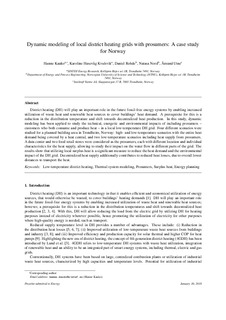| dc.contributor.author | Kauko, Hanne | |
| dc.contributor.author | Kvalsvik, Karoline Husevåg | |
| dc.contributor.author | Rohde, Daniel | |
| dc.contributor.author | Nord, Natasa | |
| dc.contributor.author | Utne, Åmund | |
| dc.date.accessioned | 2018-10-18T11:31:57Z | |
| dc.date.available | 2018-10-18T11:31:57Z | |
| dc.date.created | 2018-04-03T09:32:20Z | |
| dc.date.issued | 2018 | |
| dc.identifier.citation | Energy. 2018, 151 261-271. | nb_NO |
| dc.identifier.issn | 0360-5442 | |
| dc.identifier.uri | http://hdl.handle.net/11250/2568654 | |
| dc.description.abstract | District heating (DH) will play an important role in the future fossil-free energy systems by enabling increased utilization of waste heat and renewable heat sources to cover buildings' heat demand. A prerequisite for this is a reduction in the distribution temperature and shift towards decentralized heat production. In this study, dynamic modeling has been applied to study the technical, energetic and environmental impacts of including prosumers – customers who both consume and produce heat – in a local low-temperature DH grid. Four different scenarios were studied for a planned building area in Trondheim, Norway: high- and low-temperature scenarios with the entire heat demand being covered by a heat central, and two low-temperature scenarios including heat supply from prosumers. A data center and two food retail stores were considered as the prosumers, each with different location and individual characteristics for the heat supply, allowing to study their impact on the water flow in different parts of the grid. The results show that utilizing local surplus heat is a significant measure to reduce the heat demand and the environmental impact of the DH grid. Decentralized heat supply additionally contributes to reduced heat losses, due to overall lower distances to transport the heat. © 2018 Elsevier Ltd. All rights reserved. | nb_NO |
| dc.language.iso | eng | nb_NO |
| dc.publisher | Elsevier | nb_NO |
| dc.rights | Attribution-NonCommercial-NoDerivatives 4.0 Internasjonal | * |
| dc.rights.uri | http://creativecommons.org/licenses/by-nc-nd/4.0/deed.no | * |
| dc.title | Dynamic modeling of local district heating grids with prosumers: A case study for Norway | nb_NO |
| dc.title.alternative | Dynamic modeling of local district heating grids with prosumers: A case study for Norway | nb_NO |
| dc.type | Journal article | nb_NO |
| dc.type | Peer reviewed | nb_NO |
| dc.description.version | acceptedVersion | nb_NO |
| dc.source.pagenumber | 261-271 | nb_NO |
| dc.source.volume | 151 | nb_NO |
| dc.source.journal | Energy | nb_NO |
| dc.identifier.doi | 10.1016/j.energy.2018.03.033 | |
| dc.identifier.cristin | 1576634 | |
| dc.relation.project | Norges forskningsråd: 257632 | nb_NO |
| dc.relation.project | Norges forskningsråd: 228656 | nb_NO |
| dc.relation.project | Norges forskningsråd: 245355 | nb_NO |
| dc.description.localcode | © 2018. This is the authors’ accepted and refereed manuscript to the article. Locked until 7.3.2020 due to copyright restrictions. This manuscript version is made available under the CC-BY-NC-ND 4.0 license http://creativecommons.org/licenses/by-nc-nd/4.0/ | nb_NO |
| cristin.unitcode | 194,64,25,0 | |
| cristin.unitname | Institutt for energi- og prosessteknikk | |
| cristin.ispublished | true | |
| cristin.fulltext | postprint | |
| cristin.qualitycode | 2 | |

